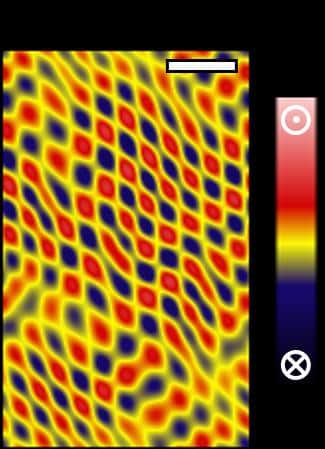
Scientists searching for magnetic skyrmions – quasiparticles with a vortex-like structure – have instead stumbled upon something even more unusual. The researchers at the University of Warwick, UK, say the object they call an “incommensurate spin crystal” resembles a skyrmion hidden in an ultrathin film with ferroelectric and ferromagnetic layers, and could be used to make storage bits for next-generation computer memories.
Skyrmions exist in many structures, notably magnetic thin films and multilayers, and are robust to external perturbations. At just tens of nanometres across, they are much smaller than the magnetic domains used to encode data in today’s disk drives. That makes them ideal building blocks for future data storage technologies such as “racetrack” memories.
Researchers identify skyrmions in a material by spotting unusual features (for example, abnormal resistivity) in the Hall effect, which occurs when electrons flow through a conductor in the presence of a magnetic field. The applied magnetic field exerts a sideways force on the electrons, leading to a voltage difference that is proportional to the strength of the field. If the conductor has an internal magnetic field or magnetic spin texture, this also affects the electrons.
Ferroelectric-ferromagnetic bilayer
Recent studies of a ferromagnetic material called strontium ruthenate (SrRuO3) produced conflicting evidence for why these unusual features exist. To investigate further, a team led by Marin Alexe constructed a bilayer consisting of a thin film of SrRuO3 and a thin film of lead titanate (PbTiO3), which is ferroelectric. Both layers are atomically flat at just 3 nm and 10 nm thick, respectively.
In these bilayer systems, the ferroelectric material (which has permanent electric dipole moments in the same way as a ferromagnet has permanent magnetic dipole moments) induces an electric field that distorts the atomic structure of the ferromagnet. This distortion, the researchers explain, breaks the ferromagnet’s symmetry.
By measuring this symmetry breaking with electron microscopy, Alexe and colleagues confirmed that an electron interaction known to stabilize skyrmions (the Dzyaloshinskii–Moriya interaction) was at work. They also measured the electrical resistivity of their SrRuO3–PbTiO3 bilayer and identified features analogous to a Hall-effect variant known as the topological Hall effect. This type of Hall effect occurs when a voltage is applied along a thin conducting sheet (like the one studied in this work) at the same time as a magnetic field is applied perpendicular to its surface, and it is an expected feature of a skyrmion system.
Not a skyrmion at all
At that point, results took a surprising turn. When the researchers used magnetic force microscopy to study the topology of their material’s micromagnetic structure, they observed a lattice based on rectangles, not hexagons as they expected. This rectangular lattice contains magnetic domains in which skyrmions should be found as individual isolated particles, but the domains they observed looked more like beads on a string or necklace. The beads did not quite form a perfect circle either, further implying that the domains actually present are not topologically protected, or isolated.
Careful examination of the images revealed that the structures were not a skyrmion at all, explains study lead author Sam Seddon. “A skyrmion causes its own complicated Hall effect and when similar-looking effects are observed it is often treated as a signature of the skyrmion,” he says. “We’ve found a very ordered domain structure, just as a skyrmion lattice would form, however they are simply chiral and not topologically protected. What this shows with real-space imaging evidence is that you don’t need a topological domain to cause a Hall effect of this kind.”

Skyrmion phases: two for the price of two
These types of interfaces between ferroelectric and ferromagnet materials could be useful for new types of computer memory, Alexe adds. “Because ferroelectric polarization can be switched permanently, this modifies a quantum effect in a ferromagnet and that might give us direction for materials for the next quantum computers,” he says. “These will need stable materials which work at extreme temperatures, are low-power consumption, and can store information for a long time, so all the ingredients are here.”
The researchers, who report their work in Nature Communications, say they now plan to continue probing the unusual physics that can arise from this type of symmetry breaking. “We will investigate, for example, novel functionalities induced by artificial symmetry breaking in different systems, including these complex spin textures, as well as two-dimensional and optically active materials,” Alexe tells Physics World.



